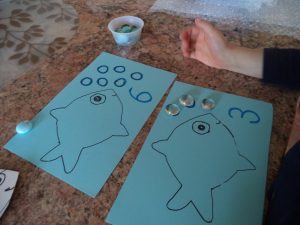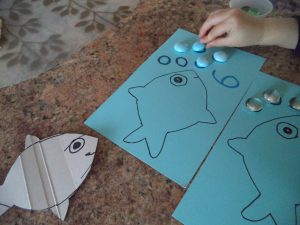With Big Sister going to school, Little Sister has been showing more interest in paper and pencil activities. She had fun counting bubbles with this simple activity.
Counting bubbles outside is almost impossible. Sometimes, instead of one single bubble floating away gently, several really small ones appear and disappear before they can be counted. But even if the counting isn’t accurate, kids can practice saying the numbers.
For small children, counting starts by saying the numbers. They need lots of opportunities to count so they develop the understanding that one number refers to one thing. This is part of number sense.
Using an idea from Anna’s blog on fish bubble counting mats, another teacher-mom, we made our own. I cut out a fish from a cereal box and traced around it on card stock, drawing some circles for bubbles. Little Sister put one flat glass marble on each circle. Together, we said the numbers.
The digit is included underneath the bubbles, but it doesn’t have to be. As long as kids are past putting items in their mouth, younger children could have just one big page and put bubbles on it for some one-to-one matching (one-to-one correspondence). Older kids may like to draw their own sea creatures and bubble circles.
Another time we do this, I’ll draw the bubbles in standard patterns, such as 4 corners for the number 4, and 2 lines of 3 bubbles for the number 6. The ability to look at a group of objects and immediately tell how many is called subitize. For example, 5 is really fast to know as soon as we see 4 corners with 1 in the middle. Dominoes, dice, and decks of cards use these patterns and they are a sort of short cut to counting. It’s also a form of visualizing, or making images in the mind. Quite likely, you do this all the time, you just didn’t know there was a word for it. Neither does spell-check!
Whatever the words, what’s most important is that kids have opportunities to play with numbers. To make this sensory, you might want to use a bowl or container of water and let kids count the marble bubbles. *Just a caution, the clear glass is really hard to see in the clear water when it comes time to pour the water in the sink! Even one in the drain is too many.* Is this counting bubbles a play-of-the-day your child might like?



 Why couldn’t the pirate play cards? Because he was standing on the deck!
Why couldn’t the pirate play cards? Because he was standing on the deck!